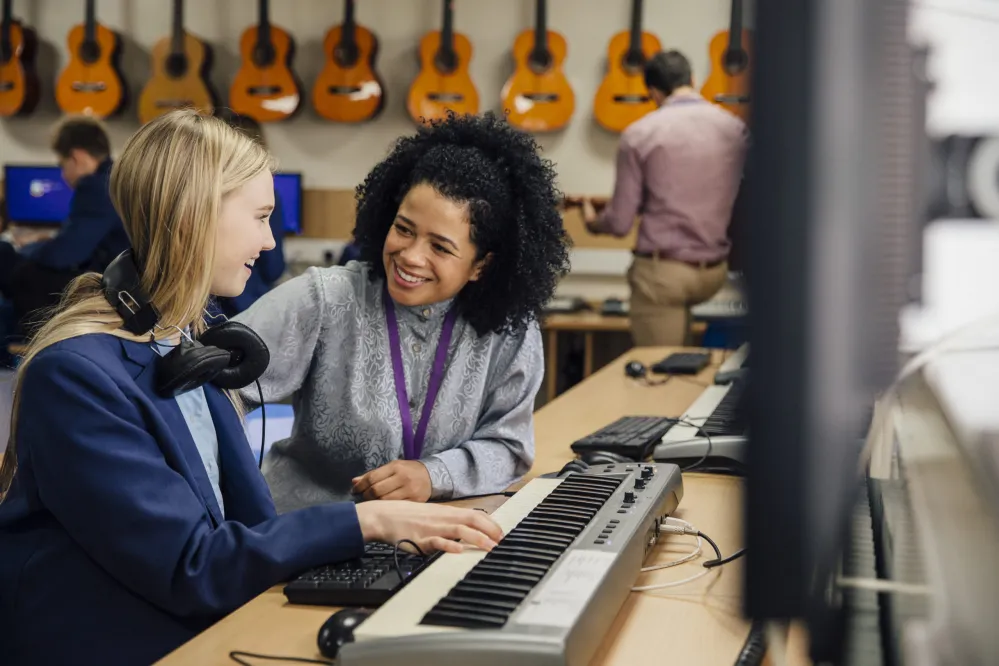Department for Education figures published 17 June show that between November 2019 and November 2020 the number of hours the arts were taught in secondary schools overall increased by +2% and the number of arts teachers did not change. However, Design & Technology continues to see falls; in the last year the number of teachers and hours taught fell by -7%. The number of children in England’s secondary schools went up by +2% over the same period.
It is also worth noting History and Geography have continued to see increases in the number of hours taught in the last year, on top of existing increases in hours taught over the last decade of 31% for History and 38% for Geography.
The 2020 figures were collected during the pandemic. These figures suggest that the anecdotal reports of the arts being removed wholesale from school curriculums due to the pandemic were isolated incidents, and not indicative of most schools.
No recovery in number of arts teachers or hours taught
Although the number of arts teachers and hours the arts are taught have remained stable for the past two years, we continue to be concerned that there has been no overall recovery in the number of arts teachers and hours taught over the last decade.
The 2020 hours taught figures for arts subjects are between -10% and -51% lower than in 2010. There are -48% less Design & Technology teachers now as in 2010, -18% less drama teachers and -9% less music teachers.
These changes need to be seen in the context of rising student numbers; there are +7% more secondary school pupils now compared to the 2010/11 school year, and in the context of increases in teachers and hours taught for EBacc subjects. For example there are now 21% more Geography teachers than a decade ago and an increase of 38% in the hours taught.
Headcount of teachers by subject
| Recorded in the November of each year | 2010 | 2018 | 2019 | 2020 | Percentage change 2010 to 2020 | Percentage change 2019 to 2020 |
| History | 15,000 | 16,855 | 16,919 | 17,132 | 14% | 1% |
| Geography | 13,500 | 15,807 | 15,774 | 16,326 | 21% | 3% |
| Design and Technology | 15,000 | 9,010 | 8,312 | 7,728 | -48% | -7% |
| Music | 7,500 | 6,525 | 6,543 | 6,837 | -9% | 4% |
| Drama | 11,100 | 8,899 | 8,963 | 9,059 | -18% | 1% |
| Art & Design | 13,200 | 11,874 | 12,112 | 12,160 | -8% | 0% |
| All arts subjects | 46,800 | 36,308 | 35,930 | 35,784 | -24% | 0% |
Hours taught by subject
| Recorded in the November of each year | 2010 | 2018 | 2019 | 2020 | Percentage change 2010 to 2020 | Percentage change 2019 to 2020 |
| History | 153,400 | 190,873 | 192,708 | 201,039 | 31% | 4% |
| Geography | 138,700 | 176,241 | 179,547 | 192,035 | 38% | 7% |
| Design and Technology | 119,900 | 68,126 | 63,056 | 58,770 | -51% | -7% |
| Music | 92,700 | 79,305 | 79,633 | 83,663 | -10% | 5% |
| Drama | 95,000 | 80,819 | 81,068 | 83,855 | -12% | 3% |
| Art & Design | 159,800 | 133,713 | 134,985 | 138,136 | -14% | 2% |
| All arts subjects | 467,400 | 361,963 | 358,742 | 364,424 | -22% | 2% |
Where does the data come from?
All data is from the Department for Education School Workforce in England statistics, which is recorded in November and the school census data recorded in January of each year.
Data for Dance is not available in the released Department for Education figures.
Number of children in England’s secondary schools
Between the 2010/2011 and 2020/2021 school year the number of children in England’s secondary schools increased by +7% (from 3,262,635 to 3,493,506). This data is from the Department for Education Schools, pupils and their characteristics statistics.
Download this page as a pdf: Arts teaching hours and workforce 2021.
Sam Cairns, Co-Director, Cultural Learning Alliance




